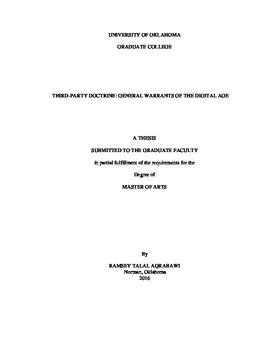| dc.contributor.advisor | Wert, Justin | |
| dc.contributor.author | Aqrabawi, Ramsey | |
| dc.date.accessioned | 2016-08-22T15:52:15Z | |
| dc.date.available | 2016-08-22T15:52:15Z | |
| dc.date.issued | 2016-08 | |
| dc.identifier.uri | https://hdl.handle.net/11244/44941 | |
| dc.description.abstract | The Third-Party Doctrine came about in the late 1970’s in two Supreme Court rulings in United States v. Miller, and Smith v. Maryland. The doctrine states that if an individual voluntarily provides information to a third party, the Fourth Amendment does not prohibit the government from accessing that information without a warrant from the third party. However, scholars studying the Third Party Doctrine have paid less attention to how the doctrine came into being, instead concentrating on the implications for jurisprudence. From a political science perspective, determining what allowed the Third-Party Doctrine to come into being is a vital question. In the past the Third-Party Doctrine might have been good law, but that time has since come to pass. It is time for Fourth Amendment law to join the 21st Century. | en_US |
| dc.language | en_US | en_US |
| dc.subject | Third-Party Doctrine | en_US |
| dc.subject | Constitutional Law | en_US |
| dc.subject | Fourth Amendment | en_US |
| dc.subject | Privacy | en_US |
| dc.title | THIRD-PARTY DOCTRINE: GENERAL WARRANTS OF THE DIGITAL AGE | en_US |
| dc.contributor.committeeMember | Szymanski, Ann-Marie | |
| dc.contributor.committeeMember | Peters, Ronald | |
| dc.date.manuscript | 2016-07 | |
| dc.thesis.degree | Master of Arts | en_US |
| ou.group | College of Arts and Sciences::Department of Political Science | en_US |
| shareok.nativefileaccess | restricted | en_US |
